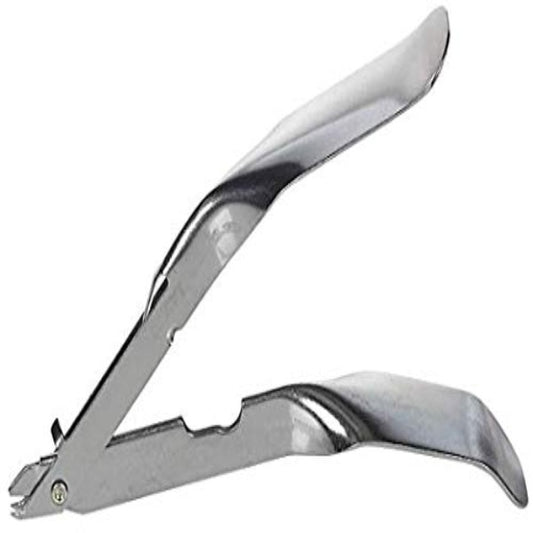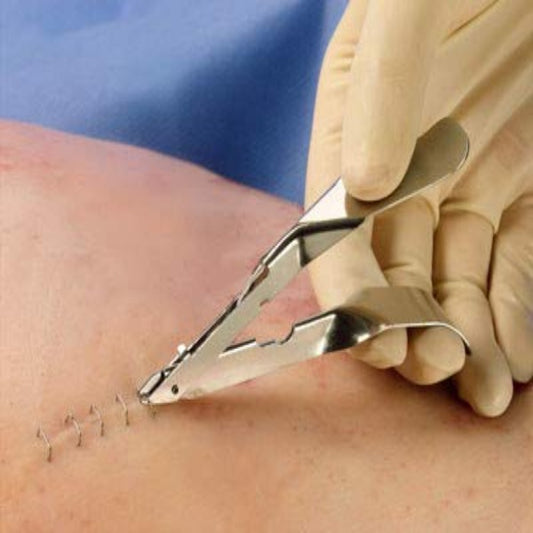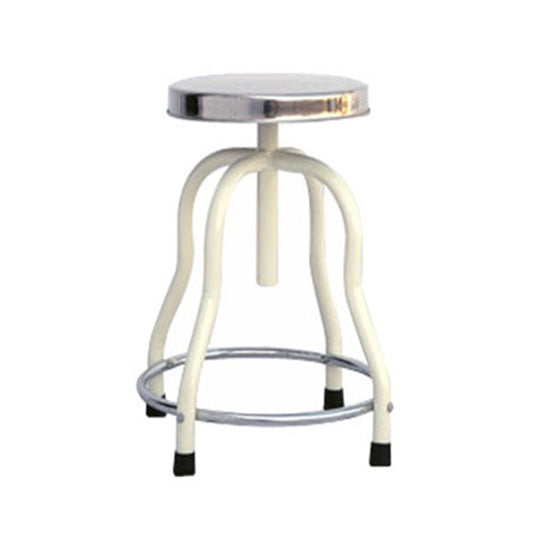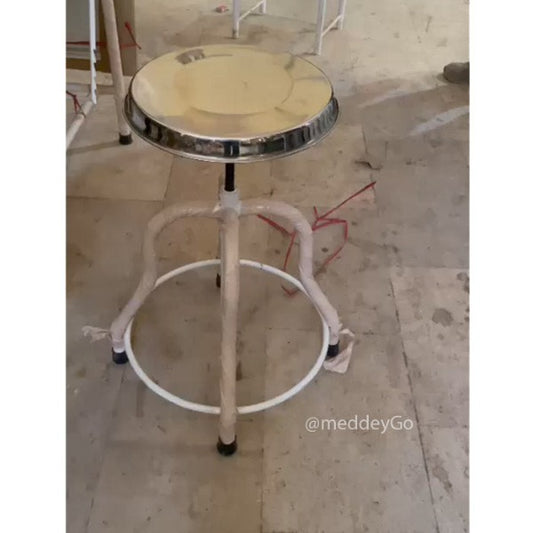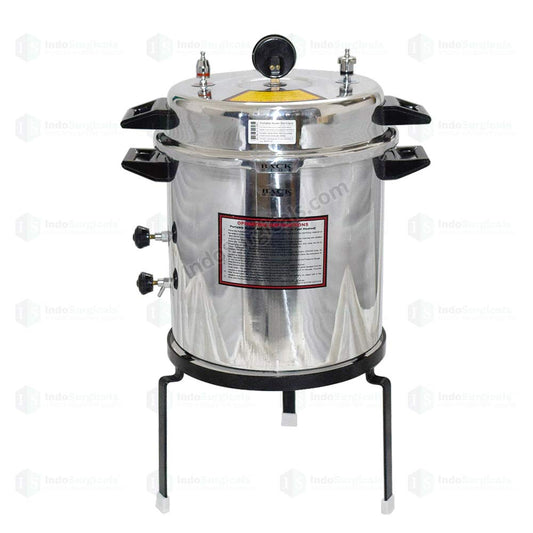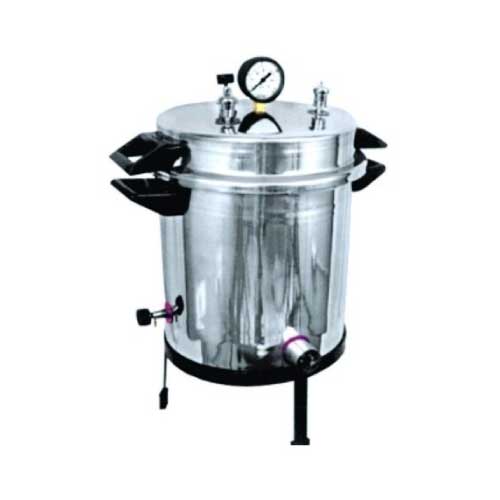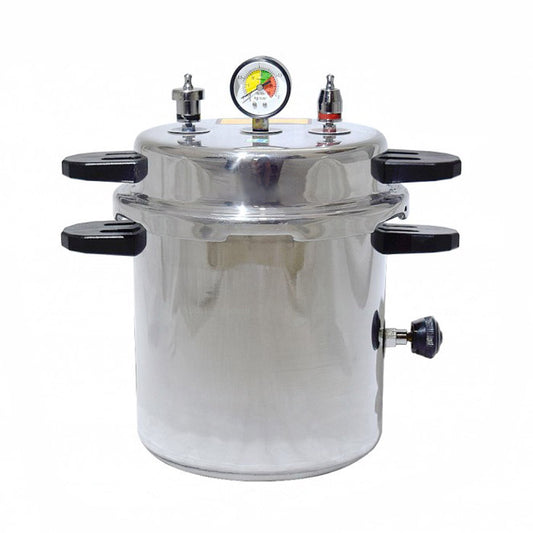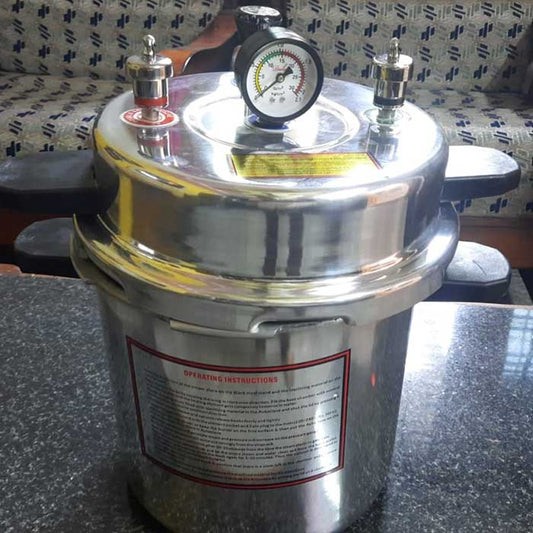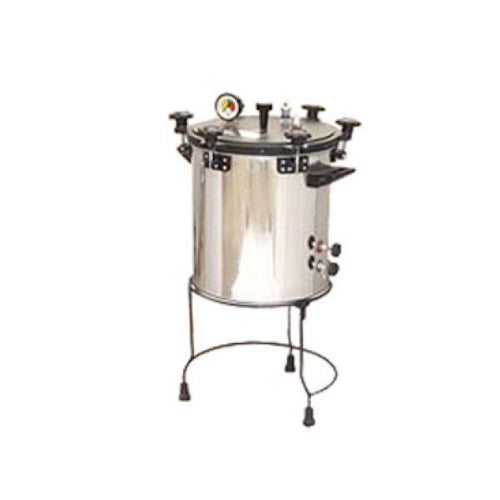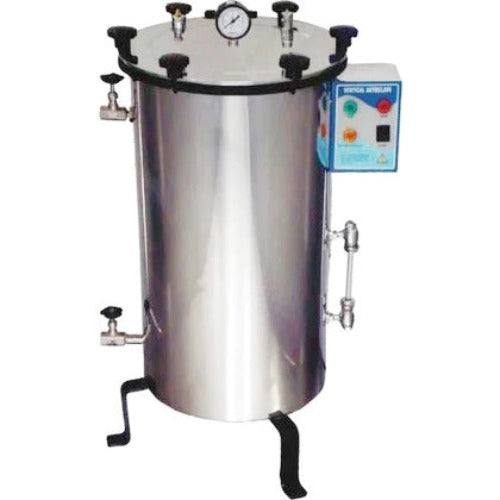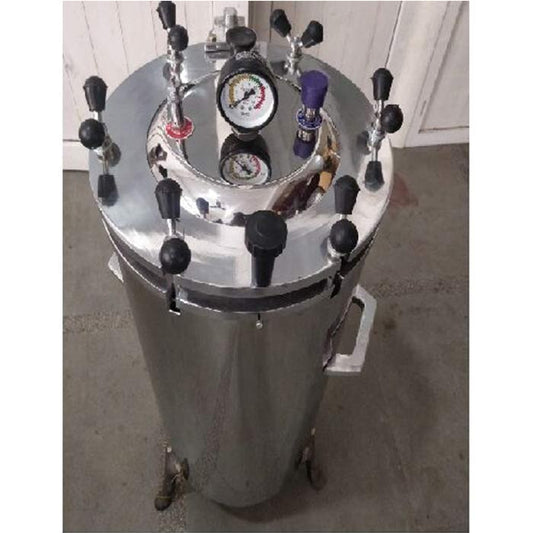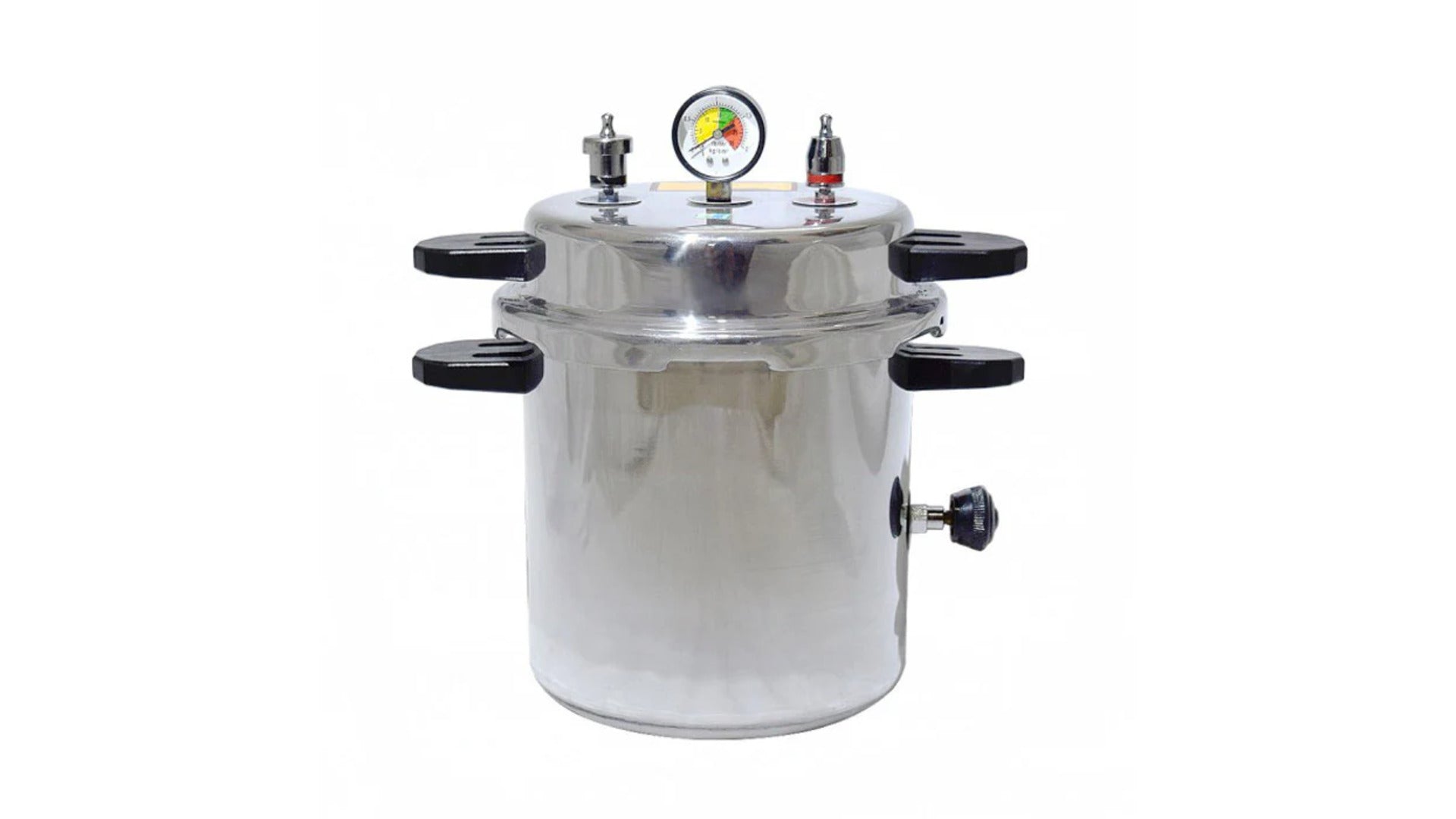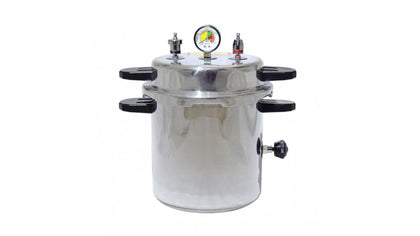-
( Prepaid or Partial COD Options are available for this product. Please call or WhatsApp us at 8586012345 ) Size approx.14" Dia. X 16" H Key Features : It uses steam to sterilize medical equipment, surgical dressings, glass, utensils, etc. rapidly and efficiently. Made...
- Rs. 13,999Inclusive of all taxes
Rs. 22,000- Rs. 13,999
- Unit price
- per
Save Rs. 8,001Inclusive of all taxes
-
More sizes availableSize Capacity 12 x 12 Inch 21 Ltr 12 x 16 Inch 29 Ltr 12 x 22 Inch 39 Ltr Specifications: Autoclave has all aluminum deep drawn seamless construction Size/Capacity: Available in 12x12 Inch (21 Ltr), 12x16 Inch (29 Ltr) and 12x22 Inch (39...
- Rs. 6,499Inclusive of all taxes
Rs. 12,000- Rs. 6,499
- Unit price
- per
Save Rs. 5,501Inclusive of all taxes
-
To sterilize medical equipment, glassware, surgical equipment, culture media, medical wastes, autoclave containers, plastic tubes, and pipete tips. Features: Equipped with pressure gauge, weight safety valve, steam safety valve, pressure regulation device, with heat resistance lid handle and body handle. It is an seamless...
- Rs. 5,999Inclusive of all taxes
Rs. 8,000- Rs. 5,999
- Unit price
- per
Save Rs. 2,001Inclusive of all taxes
-
( Prepaid or Partial COD Options are available for this product. Please call or WhatsApp us at 8586012345 ) Mirror Finish, Non- Electric (External Fuel Heated) Autoclave. All autoclaves are constructed from heavy gauge aluminum. It’s generates steam under pressure and temperature between 120°C...
- Rs. 14,999Inclusive of all taxes
Rs. 22,000- Rs. 14,999
- Unit price
- per
Save Rs. 7,001Inclusive of all taxes
-
More sizes availableVertical Autoclave – Efficient & Reliable Sterilization for Medical & Lab Use 🔹 Ensures Precision Sterilization | Double-Wall Design | Radial Locking Mechanism The Vertical Autoclave is designed to provide accurate and efficient sterilization for medical and laboratory instruments. Featuring a double-wall structure, radial...
- From Rs. 62,499Inclusive of all taxes
Rs. 85,000- From Rs. 62,499
- Unit price
- per
Save Rs. 22,501Inclusive of all taxes
Autoclaves for Hospitals: Sterilization and Safety
There is no doubt that one of the most crucial aspects in a healthcare facility is maintaining sterility to reduce infections and ensure a safe patient stay. Probably one of the most utilized tools for sterilization in hospitals would be the autoclave. An autoclave is an apparatus using steam under extreme pressure for the sterilization of medical equipment, surgical tools, and other type of equipment. With total sterilization, they remove any form of dangerous microorganism, ranging from bacteria, viruses, fungi, and even spores.
Medansh.in is the place where you can find high quality autoclaves suited to your hospital. We provide you with efficient, reliable, and long-lasting sterilization products that match the high parameters of the medical profession. Scroll down to know about Sterilizer details, specifications, types, and features, and frequently asked questions about the operation of autoclaves.
What's an Autoclave?
An autoclave sterilizes medical equipment using high-pressure steam, effectively killing bacteria, viruses, fungi, and spores on the instruments to make them safe for medical use. By preventing the occurrence and spread of infections, autoclaves ensure the sterility of medical tools before surgeries or other interventions.
Key Autoclave Features for Hospitals
1. Leading Sterilization Technology
Most modern autoclaves use steam under pressure to penetrate medical equipment extensively for adequate sterilization. High-end models incorporate vacuum pumps, which strengthen the penetration of steam into intricate or porous items like an endoscope. This makes sterilization more effective since even the tiniest crevices are free from bacteria and germs.
2. Ergonomic Touchscreen Controls
Many autoclaves have pre-programmed cycles and can easily feature touch screen controls. This makes it very easy and quite accurate to make the proper selection for the kind of material that you would want to sterilize. Medical staff can then pick any simple surgical instrument or even that tool requiring complex procedures, such as an endoscope, by just pressing a few buttons on the touch screen.
3. Various Sterilization Methods
Autoclaves have different sterilization options. These autoclaves include:
- Pre-vacuum sterilization cycles: For deep sterilization for porous items.
- Flash sterilization: For expedited processing when expediency is critical.
-
Gravity displacement cycles: For sensitive materials that require delicate sterilization.
These ensure all the materials are effectively sterilized without compromising their integrity.
4. Energy Efficiency and Quick Cycles
Hospitals prioritize energy efficiency, and new autoclaves are designed to consume less power while maintaining high performance. They also perform rapid sterilization cycles, which reduces downtime between procedures and increases patient turnover—a critical factor in high-volume departments such as surgery.
5. Sterilization Standards Compliance
The autoclaves comply with strict ISO and FDA sterilization requirements, ensuring that hospitals maintain health regulations. Healthcare providers enjoy comfort during the sterilization process, which occurs under precise temperature and pressure conditions.
6. Data Logging and Monitoring
Most autoclaves feature a data logging system that ensures recording accuracy in compliance with regulations. This system records the sterilization cycle parameters, helping hospitals maintain proper documentation for quality control. This documentation proves useful during audits and regulatory compliance.
Key Hospital Autoclave Specifications
1. Chamber Size and Capacity
The size of the autoclaves also varies according to the size of the hospital required. Small clinics require compact and countertop models, while large surgical departments benefit from using large, floor-standing autoclaves with high-volume chambers. The capacity of the autoclave, measured in liters, directly determines how many instruments can be sterilized at once.
2. Temperature and Pressure Range
The autoclave operates at temperatures between 121°C (250°F) and 134°C (273°F), with pressures ranging from 15 to 30 psi. This range effectively destroys microorganisms. Different materials that need sterilization require specific temperature and pressure cycles.
3. Cycle Time
Cycle time for sterilization 15 minutes to 1 hour, depending on the load type and the model selected. Institution with very rapid patient turnover will like autoclaves that go with the shortest cycle times and thus quickly place the instruments in action for use.
4. Compatibility with Materials
Autoclaves can sterilize different materials:
- Stainless Steel
- Glass
- Plastics
- Silicone
To prevent damage, sensitive materials like rubber or cloth require lower temperature settings. An autoclave with multiple cycles ensures safe sterilization for all types of materials.
5. Safety Features
A hospital setting is very sensitive, so many sterilizer have advertised numerous safety features including:
- Pressure relief valves
- Temperature sensors
- Self-locking door mechanisms
These features prevent accidents and provide the healthcare professional with protection from extreme temperatures and pressures when sterilization is performed.
Medansh.in Provides Different Types of Autoclaves
1. Gravity Displacement Autoclaves
The sterilizer functions by displacing air inside the chamber with steam, effectively sterilizing all inner surfaces of solid products like surgical instruments and trays.
Benefits: Dependable, it does not break the bank, and suitable for the large numbers of instruments.
2. Pre-Vacuum Autoclaves
Pre-vacuum sterilizer draw out air from the chamber before admitting steam using a vacuum pump. This allows steam to penetrate porous items; consequently, it is highly efficient for more intricate devices such as endoscopes.
Advantages: Enhanced steam penetration and sterilization of complex products.
3. Flash Sterilization Autoclaves
Flash sterilizers are used for quick sterilization of products that are available right away. Such Sterilizer are mostly utilized during surgical operating theaters when fast sterilization of instruments is required in between procedures.
Advantages: Quick cycle times are for the immediate need of sterilization.
4. Portable Autoclaves
These are compact models especially designed to be used in clinics or outpatient departments. Portable sterilizer are easy to take and store, thus ideal for facilities with confined space.
Advantages: Portable, compact and ideal for low-volume sterilizations.
| Type of Autoclave | Features |
|---|---|
| Gravity Displacement |
|
| Prevacuum Autoclave |
|
| Steam Flush Pressure Pulse |
|
| Portable Autoclave |
|
Frequently Asked Questions About Autoclaves
Q1: Which autoclave size do I need for my hospital?
A: The capacity of the sterilizer depends on the volume that you need to sterilize. For instance, large surgical departments typically require high-capacity models to handle larger volumes. Conversely, smaller clinics can opt for compact sterilizers that suit their needs.
Q2: Are modern autoclaves energy efficient?
A: Yes, modern Sterilizer are energy efficient. They consume less power; therefore, the operational cost of the hospital decreases significantly without compromising the higher standards of sterilization.
Q3: How long will a sterilization cycle take?
A: Cycle times of the autoclave depend on the model and the type of load. As such, cycle times range from 15 minutes to 1 hour for the majority of types of sterilizations.
Q4: Can all types of materials be sterilized using autoclaves?
A: Autoclaves can use a versatile range of materials, including stainless steel, glass, plastics, and silicone, among others. However, some materials are sensitive and require specific sterilization cycles in an autoclave to avoid damage.
Q5: Are autoclaves safely used in hospitals?
A: Yes, autoclaves come with all such safety features that a device needs to work safely in a hospital-like scenario with pressure relief valves, temperature sensors, and locking mechanisms, among others.
Buy High-Quality Autoclaves on Medansh.in
At Medansh.in, we provide a whole range of hospital-grade Sterilizer suited for every kind of sterilization need in your facility. We offer compact models suitable for fitting into small clinics and large models for surgical departments, aimed at keeping your hospitals up to the standards of safety and hygiene.
Medansh.in: Shop now for the best autoclave for optimal performance, energy efficiency, and patient safety. Autoclaves are any hospital's best friends, as they make sure that the medical instruments are sterilized to the point where they do not contain harmful pathogens. Advanced technology, along with several modes of sterilization, and energy-saving designs in Medansh.in's Sterilizer, assure healthcare providers reliable and durable solutions for achieving their work.

